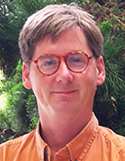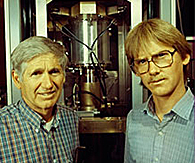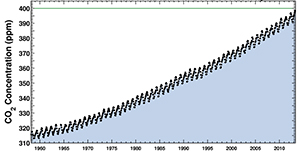When the history of humanity’s struggle to combat climate change is written, few characters will play as prominent a role as Charles David Keeling. A geochemist, Keeling developed an accurate method of measuring CO2 in the atmosphere, and in 1958 began recording background levels of the gas at the Mauna Loa Observatory in Hawaii.
That was the start of the famous Keeling Curve, which has tracked the steady rise of atmospheric carbon dioxide. Those levels have soared from 315 parts per million when Keeling began, to a grim milestone reached last week, as atmospheric concentrations exceeded 400 parts per million.

Keeling’s son, Ralph, is now the director of the California-based Scripps CO2 Program, which was founded by his father and which recently launched a Web site designed to let the public follow the unsettling rise in carbon dioxide emissions. In an interview with Yale Environment 360 senior editor Fen Montaigne, Ralph Keeling discusses his father’s work, reflects on the meaning of CO2 levels climbing higher than they’ve been in at least 800,000 years, and expresses hope that crossing the 400 ppm mark may play a role in awakening the public to the dangers of runaway climate change. “Bringing about change requires people to be aware of what’s going on,” said Keeling.
Yale Environment 360: Given your father’s work and your continuing work, what do you see as the significance of this milestone of exceeding 400 parts per million of CO2?
Ralph Keeling: Well, people like round numbers, and they remember round numbers. So this is really a moment for human awareness, just like passing a 50th birthday. This is a point to think about where we are in the course of the rise of carbon dioxide. It feels a little bit like we’re moving into another era, in that somehow between 350 and 400 parts per million feels like a certain kind of range of CO2, and now we’re moving into a different range. It feels like we’re moving into the future. Of course, we’re doing that all the time, but this is a moment to realize that that’s happening and some of the profound implications it might have.
e360: We have been passing other climate milestones, such as Arctic sea ice disappearing and glaciers melting worldwide. What do you think it’s going to take to move the public and politicians to finally begin facing up to this problem?
Keeling: Well, it’s tough, and part of it is just being aware of the significance of it. I mean, our small role here in measuring CO2 concentrations is to not just track it, but also make people aware of it. The magnitude of what’s needed can be expressed in many terms. It can be expressed in terms of what you have to do just to stabilize emissions. One way to put it in perspective is to ask the question, “What would it take to stop CO2 from continuing to grow, but just to stop at 400, not going higher?”
“We practically have to go fossil-fuel free in the next half-century or century.”
And the answer is that we would have to reduce immediately our burning of fossil fuels by something like 55 to 60 percent. So it’s a pretty drastic change. That is clearly not going to happen. If it did happen, it would be an economic catastrophe. So, it’s not in the realm of something we should hope for, but it tells you where we have to get to at some point. We have to actually move away from fossil fuel burning in such a way that we practically go fossil-fuel-free within the next half a century or century, if we’re going to avoid going above considerably higher levels like 500 parts per million. But even stopping it at 450 or 500 is going to take similar kinds of cuts, although we would have more time to do it if we started now.
e360: Is it known when the earth last had a concentration above 400 parts per million of CO2?
Keeling: The reconstructions before the ice core period, which take us only back 800,000 years, are a lot less secure. In the case of ice cores, we actually have samples of old air. And subject to some small caveats, you can simply analyze those and figure it out. In earlier geologic eras, the reconstruction of carbon dioxide depends on more indirect measurements. The work of people like Mark Pagani at Yale, who is in the business of reconstructing paleo CO2, shows that the last time that CO2 was around this level was probably in the mid-Pliocene, 2 to 4 million years ago.
e360: Let me ask you some questions about your father. Could you briefly describe his achievement and explain how it was that no one before him had accurately measured CO2 in the atmosphere?

Keeling: The interest in the subject of rising carbon dioxide and the potential for climate change was just brewing up in a significant way. At the time he started his career, he was not the first person to measure carbon dioxide concentrations in the atmosphere. Lots of previous work had been done, but mostly as an offshoot of other studies, like biologists wanting a baseline for looking at the air composition in some kind of respiratory chamber. But the methods being used before my father started were what you might characterize as wet chemical methods. They involved water and then dissolving and measuring things that are subject to what you would do in a wet chemistry lab.
They were not very precise… And that was paired with the fact that most of these measurements were done in places that were not very pristine. If you’re near a city or in a city or if you’re in a forest or near a forest, you see fluctuations in carbon dioxide that are potentially quite large. So it was kind of a fog as to what the large-scale atmosphere was really doing. Now, my father started making measurements of carbon dioxide as an offshoot of a project to study carbon in rivers. But the air measurements very quickly became more interesting, and he developed a more precise measurement method.
In the 1950s when he was doing this, liquid nitrogen, this very cold liquid, had become commercially available. And it turns out carbon dioxide is condensable in liquid nitrogen. So he basically was able to use a very simple dry method where you separate out the CO2 with this cold trapping, and then separately measure the amount of air and the amount of CO2. And it was precise to considerably better than one part per million. And he already could see a lot of structure in the variability that had never been seen before. Among the things he saw was that if he got away from a city or away from a forest, he almost always got the same value of carbon dioxide, something around 315 parts per million.
“He realized there was a stable [CO2] background, and the question was how was it changing?”
And this is a discovery that I think only in hindsight we can see as actually a key turning point in the field. He never published that as a discovery, but he used it to inspire people who could basically put together larger programs to actually track CO2 levels in the atmosphere. And the idea was that the only way you could have this stability in the concentrations if you were far away from forests and cities was if there was actually a large bit of the atmosphere that was nearly homogenous. And the setting up of the instrument at Mauna Loa, and the beginnings of measurements out there was really inspired by this idea of trying to track what was happening to this background over time. So he had a vision that it could work because he already realized there was a stable background, and then the question was, “How was it changing?”
e360: Your father passed away in 2005, and he was obviously seeing this very rapid increase in CO2 levels. What was he saying in his later years about what was happening because of this increase in CO2? And how do you think he would react to this 400 part-per-million milestone?

Keeling: It’s hard to say how he’d react, but he was for most of his life a little bit conservative about saying too much about the implications for climate. After all, his work pertained to measuring carbon dioxide itself, and other people’s work was the basis for concerns about impacts on climate. But one thing that happened to the whole scientific community through the period between about 2000 and 2010 is that there was a much larger involvement of people in reviewing the work of others and writing it up in reports such as the reports for the IPCC [Intergovernmental Panel on Climate Change]. So the community as a whole developed a larger ownership of the whole message. I do know that towards the end of his life, just before he passed away suddenly, he was moving towards being more outspoken about the seriousness of the problem.
e360: Do you see your role as one that should be more public?
Keeling: I think it’s important that the science we do be something that the public can access and understand. What I’m putting out there on the Web is focused on materials that are close to what we do. So there isn’t an in-depth discussion about implications for climate per se because that’s really someone else’s job to put that out there. But the fact that CO2 is rising, the fact that we’re crossing a milestone, the fact that it’s accelerating, and some appreciation for the magnitude of what is going on is something that really falls within the realm of what we do. And it’s an incumbent on us to make that clear to people.
e360: If emissions continue at this trajectory as we move deeper into the 21st century, how quickly do you think we could pass milestones like 450 parts per million, 500, or a doubling of CO2 from the pre-industrial era, which would be about 550 parts per million?
Keeling: Well, I would say at the pace things are going, we’ll hit 450 probably in 20, 25 years or so, and similarly we’ll hit 500 in a similar time frame after that. And if we continue accelerating, it will come even quicker than that. That is more or less an estimate based on current rates of growth. So it all plays out pretty quickly if we don’t change course. As to the doubling milestone, it’s important to point out that carbon dioxide is not the only greenhouse gas that we’re emitting. It’s also methane and nitrous oxide. So the doubling milestone will be upon us considerably sooner than the doubling of CO2. And depending upon how you figure the different contributions, we’re not that far from it even today.
e360: That’s what is known as total equivalent CO2?
Keeling: Yes, exactly.
e360: And that’s about 478 right now?
Keeling: Yeah, I think that’s right.
e360: So you think by mid-century or before we could hit that real doubling, if you add in other greenhouse gases?
Keeling: Oh, I think it’s almost for sure we will.
e360: What steps would you recommend be taken fairly soon to begin to rein in emissions?
Keeling: Again I’m not the person to think in detail how this can work or what the constraints are. But clearly we have to wean ourselves off fossil fuels. That requires developing renewable sources of energy, and we need a marketplace that allows that to happen. As long as fossil fuels are too cheap, that’s going to be hard to see. So we need some system in which the cost of the damage caused by CO2 emissions is paid at the gas pump or at the point of extraction and not by generations living later.
e360: Given this sobering milestone, is there anything out there that gives you hope?
Keeling: I’m surprised at the level of attention this is getting. It’s nice to see that people are paying attention in this way. And I think that bringing about change in the first place requires people to be aware of what’s going on, and people are seemingly quite aware. So that’s hopeful.
e360: The next step is action, but obviously that’s the hard part.
Keeling: Yes. But if you don’t see that it’s happening, it’s hard to act on it.